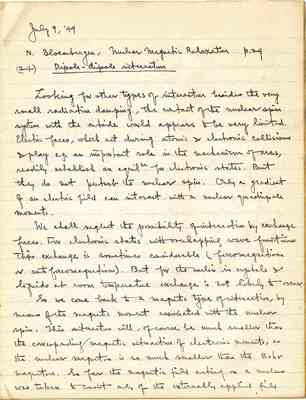Pages
7
[TOP LEFT NOTES:]
(dμ[^]→[/^])/(dt) = Ɣ (μ[^]→[/^] x H[^]→[/^])
H[v]x[/v] = H[v]1[/v] cos ωt
H[v]y[/v] = ŦH[v]1[/v] sin ωt
(D/(dt)) (μ[^]→[/^])' = Ɣ {(μ[^]→[/^])' x (-((ω[^]→[/^])/(|Ɣ|))+((H[^]→[/^])'))} = Ŧ{({left tailed ω}[^]→[/^]) (((t)(ω[^]→[/^])) ¤ (|Ɣ|)(H'))}
(μ[^]→[/^])' precesses about the fixed vector
(H[^]→[/^])' - (((ω[^]→[/^]))/(|Ɣ|)) with an angular velocity
{backwards ʎ} = square root of {(-ω + |Ɣ| H[v]0[/v])[^]2[/^] + (Ɣ[^]2[/^]H[v]1[/v][^]2[/^])} = square root of {(ω[v]0[/v] - ω)[^]2[/^] + (ω[v]1[/v][^]2[/^])}
[TOP RIGHT NOTES:]
[image: of arrow]
μ[v]x[/v]' = Ŧ cos {backwards ⱸ} A sin ({backwards ʎ}t) + sin {backwards ⱸ}B
(μ[v]z[/v]')/(?) = Ŧ sin {backwards ⱸ} A sin ({backwards ʎ}t) ¤ cos {backwards ⱸ}B
μ[v]x[/v]' sin {backwards ⱸ} - (μ[v]{?}[/v]' cos {backwards ⱸ} = B
μ[v]x[/v]' cos {backwards ⱸ} + (μ[v]z[/v]'/{?}))' sin {backwards ⱸ} = A sin ωt
H'[v]x[/v] = H[v]1[/v]
H'[v]y[/v] = 0
H[v]z[/v]' = H[v]0[/v]
[BOTTOM LEFT NOTES:] [image containing: multiplanar graph; H[v]1[/v]|Ɣ|; (ω-H[v]0[/v]|Ɣ|); ?; {backwards ʎ}; {backwards ⱸ};]
sin {backwards ⱸ} = [^][/^] (H[v]1[/v]|Ɣ|)/({backwards ʎ})
cos {backwards ⱸ} = (ω-(H[v]0[/v]|Ɣ|))/({backwards ʎ})
μ[v]x[/v]' = Ŧ cos {backwards ⱸ} (A sin ({backwards ʎ}t + ε) + B)
μ[v]z[/v]' = Ŧ sin {backwards ⱸ} (A sin ({backwards ʎ}t + ε) + B)
[BOTTOM RIGHT NOTES:]
Type II.
(μ[v]x[/v]')/(μ[v]z[/v]') = - (|Ɣ|H[v]0[/v]-ω)/(|Ɣ|H[v]1[/v]) = - δ
(d[^]2[/^]μ[v]y[/v]')/(d(t[^]2[/^])) = - ( (H[v]1[/v][^]2[/^]Ɣ[^]2[/^]) + (|Ɣ|H[v]0[/v]-ω)[^]2[/^] ) (μ[v]y[/v])'
μ[v]y[/v]' = A sin ({backwards ʎ}t)
μ[v]x[/v]' = +- (|Ɣ|H[v]0[/v]-ω)/({backwards ʎ}) A sin ({backwards ʎ}t) + ((|Ɣ|H[v]1[/v])/({backwards ʎ}))B
μ[v]z[/v]' = Ŧ (|Ɣ|H[v]1[/v])/({backwards ʎ}) A sin ({backwards ʎ}t) + ((|Ɣ|H[v]0[/v]-ω)/({backwards ʎ}))B
10
This page is not transcribed, please help transcribe this page
11
July 9, '49
N. Bloembergen, Nuclear Magnetic Relaxation p. 29 (2.4) Dipole-dipole interaction
Looking for other types of interaction besides the very small radiation damping, the contact of the nuclear spin system with the outside world appears to be very limited. Electric forces, which act during atomic & electronic collisions & play e.g. an important role in the mechanism of arcs, readily establish an equilibrium for electronic states. But they do not perturb the nuclear spin. Only a gradient of an electric field can interact with a nuclear quadripole moments.
We shall neglect the possibility of interaction by exchange forces. For electronic states with overlapping wave functions this exchange is sometimes considerable (ferromagnetism or anti ferromagnetism). But for the nuclei in crystals & liquids at room temperature exchange is not likely to occur.
So we come back to a magnetic type of interaction, by means of the magnetic moment associated with the nuclear spin. This interaction will, of course, be much smaller than the corresponding magnetic interaction of electronic moments, as the nuclear magneton is so much smaller than the Bohr magneton. So for the magnetic field acting on a nucleus was taken to consist only of the externally applied field






